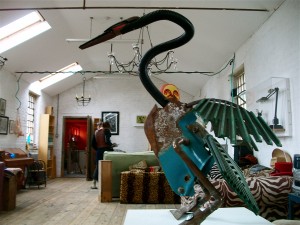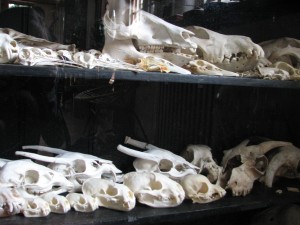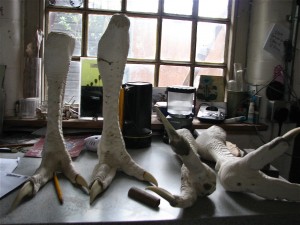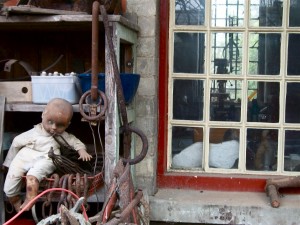【1999 Archives】
“999 ArchivesRat Is a Hero”: In the Studio with Emily Mayer
Studio Visit
 Children are posing near Damien Hirst’s large intestine. A young couple is engaged in a shoulder rub, the recipient with a bracing hand on what may be the sigmoid colon. Upstairs, caterers put flowers on round tables, and cameramen survey Tate-goers ignoring For the Love of Godencased below in a black box. In the gift shop, The Incomplete Truthanamorphic cup and saucer is on sale for £2.50.
Children are posing near Damien Hirst’s large intestine. A young couple is engaged in a shoulder rub, the recipient with a bracing hand on what may be the sigmoid colon. Upstairs, caterers put flowers on round tables, and cameramen survey Tate-goers ignoring For the Love of Godencased below in a black box. In the gift shop, The Incomplete Truthanamorphic cup and saucer is on sale for £2.50.
Between the Tate and Emily Mayer’s Norfolk studio is a gap of British countryside that from a train car feels like an hour-and-a-half stretch of live cows. I sit down and immediately hear that Emily hates instant coffee and loves rats. The Norfolk Wildlife Trust celebrates the area’s presence of weasels and more unusual species, but Emily prefers dogs to Chinese water deer. She has several dogs, some animate, some either frozen or cast in resin.
“The electricity board are coming at 8 A.M. tomorrow to cut trees,” she had written in an e-mail the night before, “and our power will be off all day. I do have a generator in our woodland cabin, so maybe I could drag that in.” It turns out that the water is out with the power, and the phones don’t work. We still manage to have coffee.
One obviously lonely tool in the studio is the cast of a cow’s head lying on the floor in a corner. There is no indication as to whether it once housed the rotting head commissioned by Damien Hirst for A Thousand Years, but it’s about the right size. A Scottish terrier mold has a more glorified place in the studio, on a front table.
With a rolled smoke in one hand and a coffee with raw milk in the other hand, Emily surveys her studio. “It’s really hard getting a hold of dead dogs. Years ago, I’d go to my vet and he’d say, you know, Help yourself, but now they all have to go to the incinerator.” A couple dogs are positioned upside down to indicate that they’re not sleeping. “I could understand a vet or anyone else doesn’t want the dog to appear later as an artwork. It would be very upsetting for the owner to come across years later.”
The studio is a lattice of intersecting patterns, ten or so drills in a row hanging on the wall; twenty panes making a grid in the window; twenty-six skulls lined up on two shelves; bolts; repeated circles of coiled copper and other wire. The studio is divided in half by a steel ceiling beam that supported the old granary upstairs. A chaos of screws, feathers, wenches, hooks and squeeze tubes of glossy red liquid align as repeating, organized shapes in the darkness. The collections are not unlike the rows of surgical tools and shelves of anatomy models that make up Invasionand Trinity—Pharmacology, Physiology, Pathologyat the Hirst retrospective in London.
 Emily walks over to The Dog’s Bollocks, a sculpture made of glass, ceramic, plastic, epoxy resin, hair, and “specimens in spirit.”
Emily walks over to The Dog’s Bollocks, a sculpture made of glass, ceramic, plastic, epoxy resin, hair, and “specimens in spirit.”
“I’m trying to do rats in more challenging positions. Not just dead rats. I think the rat, as an animal, is a hero. Because it’s not only survived, it’s also used in laboratories for testing. It’s an essential part of human life. People sort of can’t bear them.” The rat of resin and hair in the terrarium is clutching a large vial. At its feet are smaller vials, one that contains a harvest mouse and one a fetal rabbit. In the big jar, “well, that’s a dog’s bollocks.”
“The budgerigar I had in a jar until I was about ten or so. I used to pickle things. People always think of Damien and pickling. I don’t have quite the ambitions of getting a shark, though.”
The hero of Bollocksis presiding over his collection, looking as Carl Linnaeus, the Swedish botanist, must have looked gazing at the taxidermic remains of the seven-headed hydra he debunked in Hamburg. In another of Mayer’s pieces, rats are frozen mid-climb on the elbow of a table lamp shining on one of her bird sculptures. They are positioned on top of the lamp arm or perched to look at her own sculpture from its base.
Emily talks easily over the sound of electric saws. Her earrings swing; they are miniature cleavers on hooks. “I don’t have any desire to do rare or different or exciting animals. Rats and dogs are so much a part of the human condition. We invest so much emotion in both of those animals.”
She glances again at the lamp. “I also was born in the year of the rat.” Damien Hirst is the year of the snake.

Photos by Ingrid Lindquist
Daisy Atterbury writes and translates from Paris, and she directs a summer school of poetics outside of Santa Fe, NM.
Search
Categories
Latest Posts
Amazon Pet Day: All the best deals
2025-06-26 13:00Life on the Edge
2025-06-26 12:25Cruelest Summer
2025-06-26 11:13A Contemporary Novel
2025-06-26 10:55Best earbuds deal: Save 20% on Soundcore Sport X20 by Anker
2025-06-26 10:46Popular Posts
Best keyboard deals: Save on Asus gaming keyboards at Amazon
2025-06-26 13:00Queer Memories in Beijing
2025-06-26 11:55Dangerous Men
2025-06-26 11:34Mementos Mori
2025-06-26 11:32Fyre Festival and Trump’s Language
2025-06-26 11:16Featured Posts
Best tablet deal: Save $45 on Amazon Fire HD 10 tablet
2025-06-26 12:42Cosby Walks
2025-06-26 11:54Anthro-washing
2025-06-26 11:42Putin’s War Games
2025-06-26 11:06Best headphones deal: Save up to 51% on Beats at Amazon
2025-06-26 10:58Popular Articles
Best Hydro Flask deal: Save $10 on a 24
2025-06-26 12:46Hollywood Justice
2025-06-26 12:21The Well-Upholstered Nightmare
2025-06-26 11:04In Sickness and in Wealth
2025-06-26 10:35Newsletter
Subscribe to our newsletter for the latest updates.
Comments (1476)
Life Information Network
NYT mini crossword answers for May 9, 2025
2025-06-26 11:53Wisdom Information Network
Fresh Hell
2025-06-26 11:48Belief Information Network
Fleur Jaeggy’s Mourning Exercise
2025-06-26 11:16Prosperous Times Information Network
In Sickness and in Wealth
2025-06-26 11:05Charm Information Network
Best Kindle Unlimited deal: Get 3 months of Kindle Unlimited for 99 cents
2025-06-26 11:00